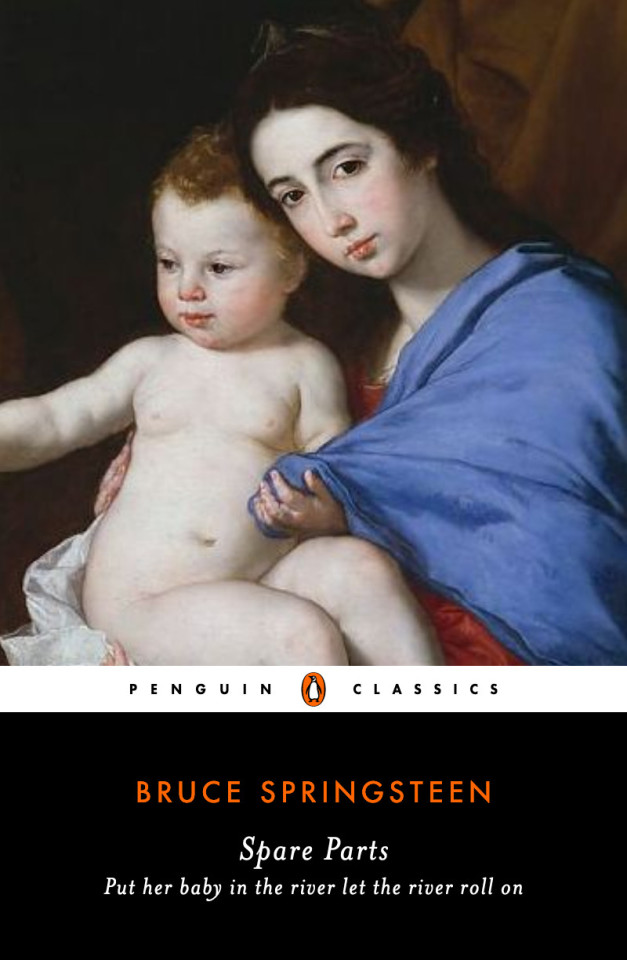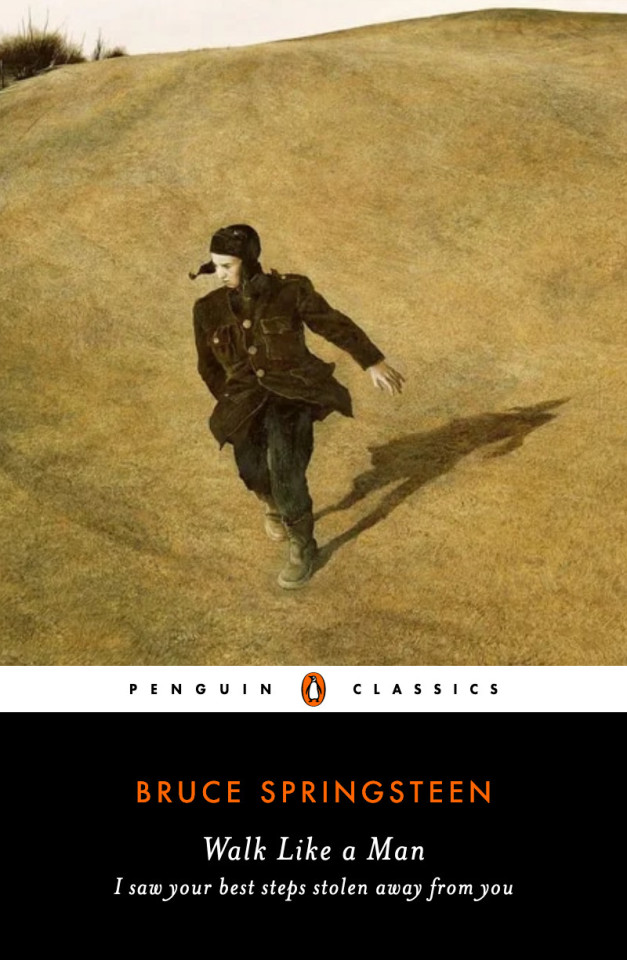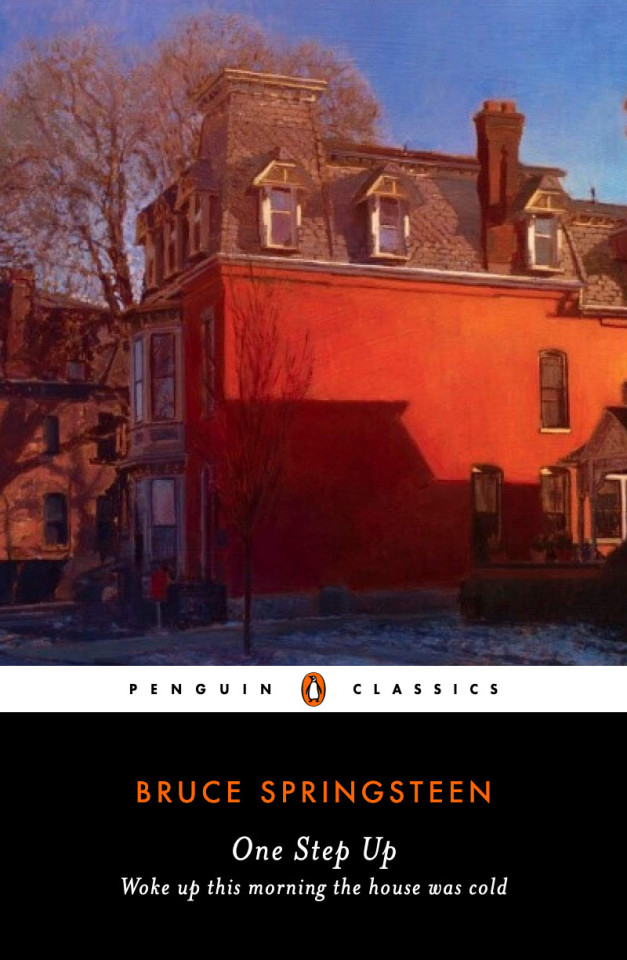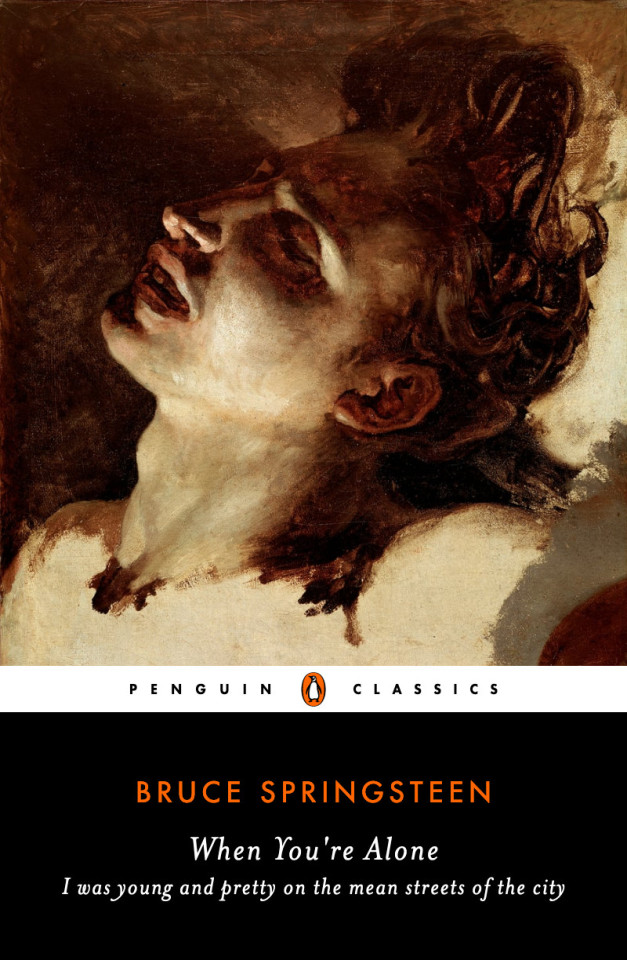#i think i found ones with similar colors to make the stylistic changes less jarring but it was tricky
Text












Bruce Springsteen's eighth album TUNNEL OF LOVE as Penguin Classics (series): Tobias Verhaecht / Kerry James Marshall / Botticelli / Jusepe de Ribera / Caravaggio / Andrew Wyeth / Raphael / Essam Marouf / Rene Magritte / Raymond Bonilla / Theodore Gericault / Soren Martinsen
#bruce springsteen#this album was so hard because that kerry james marshall painting is PERFECT for tougher than the rest#like im obsessed with it its just right... something about the eye contact over the shoulder#but its such a different style it was like impossible to make the whole set balance well#i think i found ones with similar colors to make the stylistic changes less jarring but it was tricky#also wondered: am i overusing the mary imagery? then i was like no this is bruce springsteen#anyway too complicated. too much thought for something this silly but whatever i love to have fun!#blues and oranges. applause#tunnel of love#music edits#bruce springsteen penguin classics#penguin classics edits
51 notes
·
View notes
Text
More on Zelda - Biomes, Landmarks, and Rules of Exploration
Continuing from this post on the overall structure of the original Zelda’s overworld, I’d like to talk a bit about the aesthetics, and the way its secrets are hidden.
Here, we really have to look at the map as a whole, ideally as a single image where we can see every detail. Embedding that in this post would get a little ugly, and I’d like to credit this site for throwing this together regardless, so, open this up and have a gander.
Zelda’s overworld is built from a remarkably small tileset, really. Even with palette swaps, all we have are white gravestones, those lovely blue stairs (technically drawn in three color variations if you look closely at the edges), lone boulders (brown or green), hedges (brown or green or white), wood planks for the bridges and boat docks (one of which is randomly green), a single waterfall tile, armos statues (brown green and white), water (splurging on a surprising number of unique tiles for shorelines), sand tiles for the desert (interestingly, not palette swaps of the water despite a similar texture), 5 tiles for cliffs (brown green and white) and the impressively versatile dungeon entrance tiles. Split one of the 4 tile dead trees from various places down the middle and wedge a single unique tile in for the entrance to level 1, and the statues flanking the entrance to level 4 are similarly made by recycling the tiles flanking the entrance. Two different tiles used over the doors to other dungeons (cyclops or two-eyed), using a nice little trick to give the cyclops doors pointy ears without unique tiles. And that’s it. Black squares for entrances, just a plain oaktag void for most of the ground, grey in the graveyard.
The limited variation in the color palette is an interesting stylistic choice. The jarring shift into the blocky, rectangular grey areas of the graveyard, or the sharp brown to green shifts in the eastern forest really highlights the those variable colors, brown green and white, are the only changes between palette swaps, and it almost comes across as a technical restriction that one must be used for an entire screen. On close inspection however the full palette makes a showing here and there, with a few green trees on the edges of the brown woods, or the full palette on display at the fairy ponds.
Also interesting is that the coloration of the scenery has no gameplay impact whatsoever. Green bushes and brown bushes are just as easily burned, walls just as easily blown open with bombs. It’s all about cosmetics. And frankly, with such a limited palette to draw from, it’s not entirely clear what the intent behind everything is. The brown bushes seem to indicate a dead or dying forest, thematically appropriate as you near the graveyard, or the first, skeleton filled, dungeon. The more vibrant forest to the east is also more maze-like, perhaps implying it’s overgrown. Are the green stone walls, dungeons, and armos statues meant to imply overgrowth of vines and moss? Is the grey ground in the west paved in flagstones, or meant to depict shadows? Are all the grey and white screens meant to be the interiors of natural caverns?
Regardless, what’s very clear is the impression that the entirety of the game world is ancient and abandoned. For a game with as many friendly NPCs as it has, Zelda is pointedly lacking the sort of central town one might expect (and which all of its sequels feature). The relatively high density of open cave mouths with shops and kindly old people makes it feel more civilized, but everyone’s still living in caves, or concealed under bushes. The only real artificial stuctures are the generally remote dungeons and the haunted cemetery (which is, again, hidden behind a magical forest maze). It’s not an atmosphere of sudden destruction, but more like exploring a region that was once tame and inhabited that was completely abandoned hundreds or thousands of years ago, in the process of being reclaimed by nature. The closest I can think of to a similar vibe is the wilderness of Shadow of the Colossus.
Zelda's world is also interesting in how challenging it is to fully explore. 3 out of the 9 dungeons you need to visit to complete the game are hidden, all in differing ways, with plenty of other secret areas to find, and the second quest to make it all much less obvious, and the hidden entrances really are hidden. Modern games, even within the same series, tend to telegraph all their secrets. A big cracked pattern on a wall means you can definitely blow it open with a bomb, and anything a bomb will open has such a pattern. If the candles had survived to modern iterations, we could safely assume the foliage they could remove would be similarly marked.
Zelda doesn’t hold your hand like that, turning it into a game of just noting weird features to use items on, but it isn’t totally arbitrary with where it hides things either. There are consistent rules, even if they aren’t spelled out to you. The only walls that can be bombed are along southern edges of rock formations, where a cliff face flatly joins the ground, and no given screen has more than one exit, hidden or otherwise (arguably level 6 has 3, but they all lead to the same destination). Within dungeons, all exits are neatly centered along walls where a standard door would be found, and all blocks that can be pushed to reveal secret passages are similarly found in the center row of a given screen.
I appreciate that level of obfuscation. What lead me to studying Zelda’s map like this was Zelda Randomizer rekindling the feeling of exploration the game really only has the first time, but the overworld is largely a limit to that. I don’t know what I’m going to find where, but I know all the rules to reveal secrets, and honestly, I know where all those secrets specifically are to be found, in a world whose map I’ve totally memorized. What I’m starting to plan here is a spiritual successor, which can capture the same sense of exploration, mystery, and moody atmosphere, and the same level of engagement traversing the overworld.
I’m still early enough along with this that I have to pick an engine and a graphical style, but I want to use a method of proceedural generation to create overworlds like this one. Random sure, but with distinct regions, landmarks, and choke points. I’m thinking, maybe throw in some big deliberate features, akin to the lake with level 1 and the graveyard, pulled from a bank of several options, force some natural split across the map with a means of shortcutting it later, and large blocks of certain aesthetic biomes would do the trick. Still, I’m open to suggestions here.
4 notes
·
View notes
Link
There’s a reason movies employ costume designers, why celebrities hire stylists, and why you changed outfits no fewer than three times before your last promising first date — fashion choices broadcast nuanced details about a person’s identity and personality.
The same, of course, holds true for fictional characters in novels. The choices that authors make about apparel and accessories can bring a character to life, or they can push fiction into fantasy. Remember when Carrie Bradshaw picked apart Jack Berger’s novel because he dressed his character in a then-unfashionable scrunchie? Select the right pieces and your character will feel real; select the wrong ones and readers won’t believe a word.
Scrunchies aside, stylistic choices have turned so many moments from capital-L Literature into memorable scenes. In Gone With the Wind, Scarlett O’Hara whipped up an iconic gown out of green curtains during the poverty-stricken days of Reconstruction, when she couldn’t afford to purchase a dress. In Jane Eyre, the protagonist refuses to wear the brightly colored silk and satin gowns Mr. Rochester offers her in favor of the drab dresses she feels are more appropriate for her position as a governess. In The Bell Jar, Esther Greenwood immediately divulges by page three that she rushed over to Bloomingdale’s on her lunch break to purchase black patent leather shoes with a matching belt and handbag to prepare for her summer of working at a magazine in New York — that’s how important her accessories are to her. And who can forget The Great Gatsby’s Jay manically tossing up shirts, or American Psycho’s Patrick Bateman reciting a list of designers and brand names with the reverence usually reserved for church?
If these scenes seem particularly vivid to you, it might be because each of these classics has been adapted onscreen, as so many best-sellers are (including two of the books below). That creates further opportunity for these looks to come to life.
I asked the authors of five buzzy novels to select one important look they’ve created for a specific character and dissect what the ensemble means to the character. How does she choose to dress herself, and what does that signify about who she is? The outfits themselves vary wildly from a disheveled 1940s ostrich feather ball gown to a worn-out Lilly Pulitzer tank top, but each author emphasized the same point: Their choices were intentional. Nothing was accidental or poorly thought-out. One author went on an online shopping frenzy to dress her character for a wedding; another even brought in an outside stylist to ensure the clothes were up to date.
The next time you pick up a novel, pay special attention to what each character wears — every outfit is a road map of their values, tastes, history, and insecurities. Below, five authors reveal how they use fashion as a tool in fiction.
Half the fun of zipping through the rollicking family drama of Crazy Rich Asians is the fashion. Kevin Kwan makes it clear that among certain circles in upper-crust Asian society, you’re only worth as much as the labels you choose to wear — and the tackiest thing you can do is to dress above your station. “When I write all my characters, I really imagine from head to toe every single thing they’re wearing,” Kwan says. “If I didn’t already know the piece, I would scour the internet, looking at collections and creating outfits for the characters.”
Astrid Leong in her VBH earrings.
Crazy Rich Asians follows Rachel Chu, an American-born professor, who travels to Asia to meet her boyfriend Nick Young’s astronomically wealthy family for the first time. Astrid Leong is Nick’s beloved cousin; she’s a stay-at-home wife and mother, as well as a fashion icon among the elite. She flies to Paris every season for custom couture and had a close friendship with Yves Saint Laurent (RIP), but she’s not afraid to wear a dress off the rack from Zara … as long as it’s styled just so with museum-quality Etruscan bangles.
“Astrid is very much inspired by one person,” Kwan says; he tried to recreate her style for the book. “Astrid sees dressing as her only form of artistic expression. She lives in this very cloistered world where she has to put the right foot forward at all times. Fashion, for her, is a way of being rebellious, and it’s a way of asserting her own creative expression into her life.”
Kwan discovered this Alexis Mabille white peasant blouse back in 2010 and was inspired to dress Astrid in it for a Friday night dinner at her grandmother’s house, where a more relaxed outfit would make sense. She’s dressed down in order to detract attention from her new VBH earrings — a splurge that would make her slightly less wealthy husband uncomfortable. “She pairs the earrings with something that’s just kind of more fun and casual so the earrings look like costume jewelry,” Kwan notes.
While writing the next books in the trilogy, China Rich Girlfriend and Rich People Problems, Kwan turned to Cleo Davis-Urman, now the Fashion Director of Saks Fifth Avenue, to source apparel and accessories for his characters. “I was so frantically busy trying to meet my deadlines that her help in keeping up to date on the latest fashions was invaluable,” he says.
Crazy Rich Asians hit theaters this summer, with costumes by Mary Vogt (her past projects include Hocus Pocus and Men in Black). Kwan says that Vogt often mirrored exact outfits from the book, like Araminta Lee’s gold jumpsuit at her bachelorette party and the beige linen suit Nick wears to greet Rachel at Tyersall Park for the first time.
Social Creature is what would happen if an overgrown Eloise at the Plaza had a wardrobe full of stained vintage dresses and an eccentric pack of friends — and if she wound up dead. The glamorous thriller follows Louise Wilson, a mousy underachiever whose life changes overnight when she meets Lavinia Williams, a madcap bombshell who frolics at the opera, trades witty barbs at secret bookstores, and dances at a stand-in for the McKittrick Hotel.
“My vision for Lavinia is the little kid who goes into her parents’ wardrobe and comes out wearing everything,” Tara Isabella Burton (a staff writer at Vox) says. She swathes herself in vintage from the 1920s through the ’50s, but she doesn’t have the self-care skills required to preserve her delicate clothes. “She definitely leaves her clothes rumpled in a pile on her floor when she stumbles home drunk. She does not fold things neatly. She is constantly drinking and spilling shit,” Burton adds. From afar, thanks to her class privilege and sheer force of personality, Lavinia succeeds in looking like an effortless sylph. But up close, she’s a mess.
Lavinia with her gorgeous dress caught on a door.
She comes from a wealthy family and veers wildly between using her money to attract and keep friends and feeling self-conscious about her background. She’s likely to spend hundreds at a curated vintage store but lie and say she found a dress at a thrift shop for $5. “It’s very much in the Upper East Side, WASP-y vein to downplay and be like, ‘Oh, this old thing? It was on sale! Of course I didn’t pay for it!’” says Burton.
The first time readers meet Lavinia, she flies into the brownstone she shares with her teen sister, Cordelia, at 6 am. Louise, Cordelia’s SAT tutor, has been up all night waiting for Lavinia to come home to pay her. Lavinia accidentally slams the door on the ostrich feather hem of her 1940s ball gown and sheds feathers everywhere she walks, like an injured bird. Louise is able to mend the dress for her, which sparks the beginning of their dangerously codependent friendship.
At the New York launch party for Social Creature, Burton wore a similar ostrich feather gown in pale pink. She says she didn’t intend to match Lavinia but liked that the gown “felt very Social Creature.” She also Sharpied on a “More Poetry!!!” arm tattoo, like the ones Louise and Lavinia get together in the book. At the party, Burton’s fake tattoo smudged off onto her dress, and she dabbed out the stain with a wet napkin. Unlike her character, she could take care of her vintage duds.
Imagine this: You get stuck in an elevator with your dream guy. He invites you to be his plus one to his ex’s wedding, less than 48 hours away. That’s the meet-cute that kicks off The Wedding Date. To dress Alexa Monroe and the other characters in the book, Jasmine Guillory thought carefully about how their wardrobes would function practically in their lives.
Alexa in her red dress.
Alexa is the chief of staff for the mayor of Berkeley, and her wardrobe is mostly work clothes. She opts for colorful shift dresses and blazers from department stores; she’s a little preppy and likes J.Crew. She’d love to wear a Theory suit, but she’s busty, so blazers don’t always fit her the way she’d hope. For the past few weddings she’s attended, she’s either been a bridesmaid or done Rent the Runway, so she has to scramble for something to wear. She summons her best friend Maddie, a stylist, for a day of shopping.
“I did a lot of mock online shopping for what Alexa would wear to this wedding,” Guillory says. “I wanted her to feel like the star version of herself, like she has a glow about her the whole night.” Guillory — or Maddie — ultimately selects a red fit-and-flare cocktail dress with a low neckline. The cut of the dress was intentional; Guillory wanted Alexa to be able to wear it without Spanx underneath, in case she happened to later undress in front of her wedding date, Drew Nichols. Instead, she would be able to wear the dress with a pretty, sexy bra and panty set.
For Alexa, the dress inspires a serious confidence boost. “Normally, she would think, ‘Oh, a guy like this would not be interested in me,’” Guillory explains. “But with that dress on, she feels like Cinderella. … It’s kind of a magic dress and a magic night, so she might as well flirt with the hot guy. Why not?”
High school freshman Chloe Sayers can fit in with anyone in her small New Hampshire town: She looks like a popular kid, dreams of life as an artist, and is best friends with misfit Jon Bronson, who’s secretly in love with her. Jon is kidnapped, only to mysteriously return four years later with no recollection of what has happened and with strange powers that threaten those around him. Meanwhile, in Providence, Rhode Island, Detective Charles “Eggs” DeBenedictus is investigating a string of seemingly healthy young people who keep dropping dead. The genre-bending novel follows their three separate but interconnected lives.
Chloe in her casual hometown outfit.
More than a decade later, Chloe is a hotshot New York artist whose portraits of Jon have made her a star. She’s been deeply uncomfortable dressing up ever since her high school prom, when she wore a revealing dress she didn’t like. Typically, she’s in paint-splattered cutoffs and big, old T-shirts — easy pieces to throw on when she’s making art. She’s keenly aware that setting and context matter: When she’s back home in New Hampshire, god forbid she dress up and offend people’s casual sensibilities; when she’s out in New York with her Entourage-loving financier fiancé, she knows to dress for his newly urban tastes, even though he’s from her small New England hometown too. “She wishes she didn’t care so much, but she does,” Caroline Kepnes explains.
The morning after her big engagement party in her hometown, Chloe is getting dressed to reunite with Jon. At first, she chooses a little pink dress, but she knows her fiancé’s family would sneer and call her overdressed. Instead, she throws on an old Lilly Pulitzer tank top and denim cutoffs. Her fiancé’s sister-in-law sneers, anyway. “Chloe doesn’t wear Lilly in New York,” Kepnes explains. “She wears it in Nashua to fuck with her would-be sisters-in-law who read Lilly as, ‘So you think you’re better than me, huh?’”
As a teenager, in the wake of Jon’s disappearance, Kepnes says Chloe’s “whole identity was constantly nitpicked and torn apart, so she’s more relaxed. She’s like, ‘No matter what I do, they’re going to say something, so I’m just going to wear what I wear.’” Depending on whom you ask, a classically printed Lilly tank top is either obnoxiously preppy or sweetly nostalgic; for Chloe, in this moment, it’s a form of expression and rebellion.
Lara Jean Song Covey is the 16-year-old protagonist of Jenny Han’s trilogy To All the Boys I’ve Loved Before (the Netflix adaptation came out this August). A true romantic, she writes letters to every boy she’s ever had feelings for and stashes them away in a teal hatbox given to her by her late mother. When the letters accidentally get sent to each boy in question, well, Lara Jean’s life quickly gets pretty interesting.
Lara Jean in her iconic knee socks and cardigan.
“Her look is 1960s retro meets 1990s meets Asian streetwear,” Han says. “It’s aspirationally romantic schoolgirl, and as an introverted person, it’s her way to express herself.” Lara Jean draws inspiration from Asian fashion blogs, wears clothes that her aunt sends her from Korea, and likes to shop at vintage stores. Han referenced the movie Clueless and Korean fast fashion from sites like Stylenanda to develop Lara Jean’s style. She gave her three recurring style signatures: a hair bow, a heart-shaped locket, and knee socks.
The socks have become such a fixture among fans, Han says, that readers often wear them to book signings as a tribute to the character. “Her style came together in a way that made sense to me because of her romantic nature, her fascination with the past, and her idea of what love looks like,” she says.
This outfit is something Lara Jean wears for a regular day at school. It also appears in the final scene in the movie. “I had extensive conversations with the producers in regard to Lara Jean’s style,” Han says. “I sent them mood boards.” This particular silhouette — a button-down with a short skirt — is used frequently.
Ultimately, Lara Jean’s look is also somewhat influenced by Han’s personal tastes. “It’s very similar to my style,” she says.
Original Source -> How do you choose an outfit for a fictional character? 5 authors explain.
via The Conservative Brief
0 notes